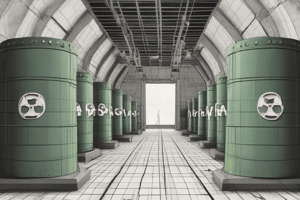Podcast
Questions and Answers
Which type of infectious waste should be placed in a puncture-proof red container?
Which type of infectious waste should be placed in a puncture-proof red container?
- Sharps (correct)
- Contaminated glassware and packages
- Urine and excreta from patients treated with radionuclides
- Sealed sources
What type of waste is typically placed in a yellow container with the biohazard symbol?
What type of waste is typically placed in a yellow container with the biohazard symbol?
- Radioactive waste
- Chemical waste
- Expired pharmaceutical waste
- Infectious waste (correct)
What is the minimum thickness required for the yellow plastic liner used to collect infectious waste?
What is the minimum thickness required for the yellow plastic liner used to collect infectious waste?
- 0.007 mm
- 0.009 mm (correct)
- 0.005 mm
- 0.01 mm
What information should be included on the tag for an infectious waste container?
What information should be included on the tag for an infectious waste container?
Which of the following is NOT considered infectious waste?
Which of the following is NOT considered infectious waste?
What is the purpose of the biohazard symbol on an infectious waste container?
What is the purpose of the biohazard symbol on an infectious waste container?
Which of the following is considered infectious waste?
Which of the following is considered infectious waste?
What category does waste containing body fluids fall under?
What category does waste containing body fluids fall under?
Which of the following is an example of sharps waste?
Which of the following is an example of sharps waste?
How should infectious waste be stored at the source site?
How should infectious waste be stored at the source site?
Which type of waste requires special handling due to its potential to cause genetic mutations?
Which type of waste requires special handling due to its potential to cause genetic mutations?
What should be done with expired or no longer needed laboratory reagents?
What should be done with expired or no longer needed laboratory reagents?
What type of container is required for sharps waste?
What type of container is required for sharps waste?
What color and labeling is required for chemical waste containers?
What color and labeling is required for chemical waste containers?
What additional information must be included on pharmaceutical waste containers?
What additional information must be included on pharmaceutical waste containers?
What type of container is required for radioactive waste?
What type of container is required for radioactive waste?
What information must be included on general waste containers?
What information must be included on general waste containers?
Which type of waste container allows for the use of a recycle symbol?
Which type of waste container allows for the use of a recycle symbol?
Flashcards are hidden until you start studying
Study Notes
Types of Waste
- Infectious waste: suspected to contain pathogens, includes laboratory cultures, waste from isolation wards, and materials in contact with infected patients
- Pathological and anatomical waste: human tissues, organs, or body fluids
- Sharps: sharp waste that can cause cuts, pricks, or punctures, includes needles, infusion sets, scalpels, and knives
- Pharmaceutical waste: expired, spilt, or contaminated pharmaceutical products
- Genotoxic waste: waste containing substances with genotoxic properties
- Chemical waste: waste containing chemical substances generated during disinfection and sterilization procedures
- Radioactive waste: waste containing radioactive substances
- Non-hazardous or general waste: waste that has not been in contact with communicable or infectious agents, hazardous chemicals, or radioactive substances
Waste Segregation and Storage
- Infectious waste: yellow container with biohazard symbol, 0.009mm thickness, and labelled "infectious waste"
- Pathological and anatomical waste: yellow container with biohazard symbol, 0.009mm thickness, and labelled "pathological/anatomical waste"
- Sharps: punctured-proof container with wide-mouth, labelled "sharps", and biohazard symbol
- Chemical waste: labelled "chemical waste", yellow with black band, 0.009mm thickness, and tagged with source and weight of waste
- Pharmaceutical waste: labelled "pharmaceutical waste", yellow with black band, 0.009mm thickness, and tagged with source and weight of waste
- Radioactive waste: radiation-proof repository, leak-proof, and lead-lined container, labelled with name of radionuclide and date of deposition
- General waste: optional recycle symbol, black or colorless plastic, 0.009mm thickness, and tagged with source and weight of waste
Guidelines for Proper Labelling, Marking, and Color Coding
- Use of biohazard symbol is optional
- Labeling and tagging of waste with source, weight, and date of collection
- Color coding: yellow for infectious, pathological, and anatomical waste; yellow with black band for chemical and pharmaceutical waste; orange for radioactive waste; black or colorless for general waste
Laboratory Safety and Waste Disposal
- Report accidents in the laboratory immediately
- Disinfect working area before and after laboratory procedures
- Practice proper disposal of waste materials inside the laboratory classroom
Studying That Suits You
Use AI to generate personalized quizzes and flashcards to suit your learning preferences.




